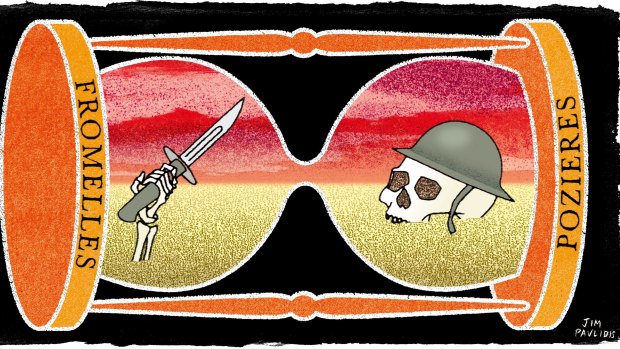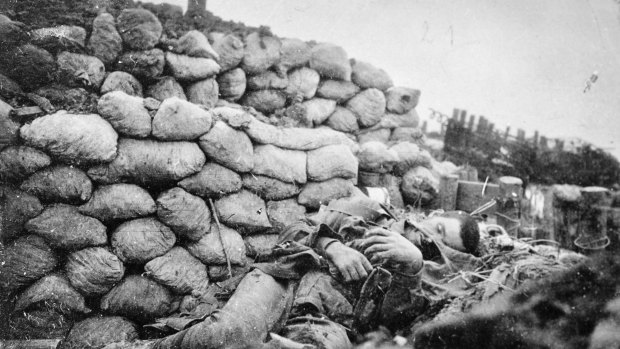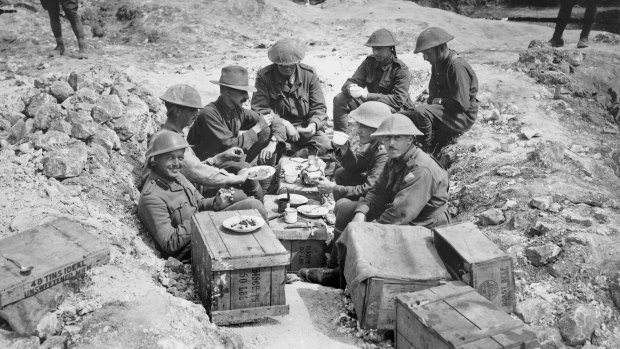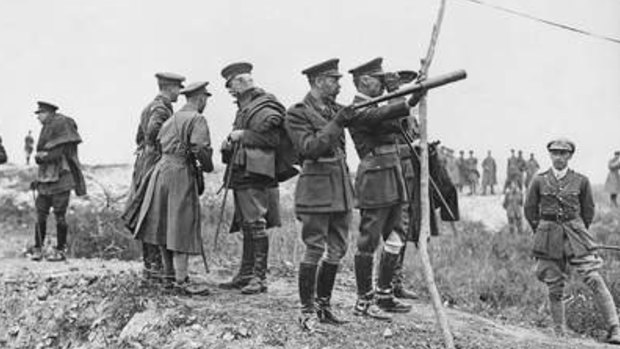By Peter FitzSimons
This week will see the centenary of two horrific battles on the Western Front engaged in by Australian soldiers. Both battles, Australian veterans agreed, made their experience at the far more fabled Gallipoli look like "a picnic" – a recurring theme I and my researchers came across in diaries and letters we went through when I did a book on both battles last year.
And it is easy to see why. In Gallipoli, after an eight-month campaign, Australia had 8700 Diggers killed. At Fromelles, we sent forward 7000 soldiers of the 5th Division, to suffer 1900 men killed in one night.

Illustration: Jim Pavlidis
Fromelles was a hideous defeat, an ill-conceived operation from the first. When the great Australian general Pompey Elliott first saw the orders five days before the battle, he wasted no time in grabbing the most senior British officer he could find, one of British Commander General Haig's officers, Major Harry Howard, to fiercely remonstrate against the English plan.
Elliott took him to the spot known as VC Corner, just opposite the main German bunker at Fromelles, the "Sugarloaf", a squat lump of concrete in the distance, bristling with machine-guns poking out from angry slits.

The body of an Australian soldier killed in fighting near the Battle of Fromelles on July 19 and 20 in 1916.Credit: Australian War Memorial, A01566
Do you see, Major Howard? To get to it, to even begin to attack it, his men will have to cover 400 yards of open ground, under fire from shot and shell, shattered by shrapnel. All of it in bright sunlight, for a starting time before 6pm!
"Major," Elliott says firmly. "I want you now to tell me as man to man, in view of the fact that you have had nearly two years experience in this fighting as against my 10 days, whether this attack can succeed."
Major Howard is, frankly, a little stunned, but tells him anyway. He frankly expects it to be "a bloody holocaust".
Howard at least promises to go back to GHQ, talk to General Douglas Haig, and try to have the orders changed. But to no avail.

A group of Australian officers having breakfast in a shell hole in Sausage Valley in the forward area near Pozieres, France.Credit: Australian War Memorial/EZ0075
And the Germans – including Corporal Adolf Hitler as it turns out – certainly know they are coming. For hours before the Australians are due to go over the top, on the late afternoon of 19 July 1916, the German artillery zeroes in.
"The first thing that struck you," one of the Australian officers will later tell Charles Bean, "was that shells were bursting everywhere, mostly high-explosive; and you could see machine-guns knocking bits off the trees in front of the reserve line and sparking against the wire ... When men looked over the top they saw no-man's-land leaping up everywhere in showers of dust and sand."

King George V, holding telescope, watching the battle of Pozieres from captured ground. The Prince of Wales is behind the King talking to two officers.Credit: Australian War Memorial
Are they really going to charge out into that, in broad daylight, just to get to still intact rolls of barbed wire? Is the plan really for them to have more men left over than the Germans have bullets?
Pretty much, but it is not just a plan; it is an order.
Inevitably, inexorably, it must happen. The "hourglass of eternity", drops another tiny grain of sand, labelled "5.43pm".
"As they [went over]," one Digger records, "Fritz opened up with machine-guns and rifles, but on they went, undaunted."
Within seconds, all of them are disappearing into the heavy smoke now lying over No Man's Land from all the shell fire.
In the Sugarloaf, the hands of the German machine-gunners become so badly scorched that the smell of burning skin fills the interior. Despite it all, the Australians keep attacking through the night, before, finally, early next morning, some sanity prevails and the order is given to withdraw. The result: a bloody holocaust. More Australians were killed on that terrible night than in the Boer War, Korea, Vietnam and Afghanistan put together.
The battle of Pozieres started a little over three days later, just after midnight on July 23. The Brits had fought for three weeks to take the town, since the beginning of the Battle of the Somme on July 1, and now the Australians of the 1st Division have been sent for.
Among these most forward soldiers, preparing to charge, is Lance-Corporal Harold "Squatter" Preston of the 9th Battalion, who tries to press his body as close into the bosom of Mother Earth as possible.
The advisability of this measure is emphasised when, 'neath the fading, flickering, ethereal light thrown by the endless flares, the men note that the German machine-gun bullets are now so low that "we could see [them] cutting off the poppies almost against our heads".
Nearby, 19-year-old Lance-Corporal from the AIF's 1st Battalion, Ben Champion, is doing his best not to wet himself, but just cannot help it. "I couldn't stop urinating," he would recount in his diary. "It seemed as if the earth opened up with a crash. The ground shook and trembled, and the concussion made our ears ring."
But now the whistle blows and they charge. Again, the battle goes through the night, and this time the Australians triumph, capturing most of the town. Haig himself would note, "the capture of Pozieres by the Australians would live in history!"
The true struggle would come over the next weeks, as the Australians must push higher still up the slope from Pozieres, to try to take the strategic target, the windmill, the highest site in the Somme Valley. And they take that, too. But, oh, the cost.
"That crowded mile of summit at [Pozieres]," the great war correspondent and historian Charles Bean would note, "is more densely sown with Australian sacrifice than any other place on earth ..."
I will be there for the last of those centenaries, and will shed a tear – as should we all – for so many young lives lost, so many of them in such a tragically ill-conceived venture.
Lest we Forget.
Christ.
Twitter: Peter_Fitz